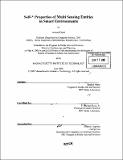Self-* properties of multi sensing entities in smart environments
Author(s)
Pilpré, Arnaud
DownloadFull printable version (5.330Mb)
Other Contributors
Massachusetts Institute of Technology. Dept. of Architecture. Program In Media Arts and Sciences
Advisor
V. Michael Bove, Jr.
Terms of use
Metadata
Show full item recordAbstract
Computers and sensors are more and more often embedded into everyday objects, woven into garments, "painted" on architecture or deployed directly into the environment. They monitor the environment, process the information and extract knowledge that their designed and programmers hope will be interesting. As the number and variety of these sensors and their connections increase, so does the complexity of the networks in which they operate. Deployment, management, and repair become difficult to perform manually. It is, then, particularly appealing to design a software architecture that can achieve the necessary organizational structures without requiring human intervention. Focusing on image sensing and machine vision techniques, we propose to investigate how small, unspecialized, low-processing sensing entities can self-organize to create a scalable, fault tolerant, decentralized, and easily reconfigurable system for smart environments and how these entities self-adapt to optimize their contribution in the presence of constraints inherent to sensor networks.
Description
Thesis (S.M.)--Massachusetts Institute of Technology, School of Architecture and Planning, Program in Media Arts and Sciences, 2005. Includes bibliographical references (p. 78-87).
Date issued
2005Department
Program in Media Arts and Sciences (Massachusetts Institute of Technology)Publisher
Massachusetts Institute of Technology
Keywords
Architecture. Program In Media Arts and Sciences